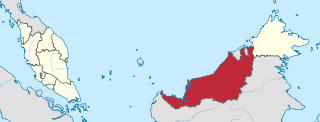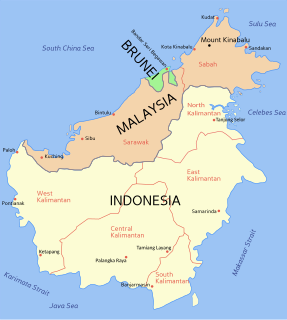
Borneo is the third-largest island in the world and the largest in Asia. At the geographic centre of Maritime Southeast Asia, in relation to major Indonesian islands, it is located north of Java, west of Sulawesi, and east of Sumatra.

Sarawak is a state of Malaysia. The largest among the 13 states, with an area almost equal to that of Peninsular Malaysia, Sarawak is located in northwest Borneo Island, and is bordered by the Malaysian state of Sabah to the northeast, Kalimantan to the south, and Brunei in the north. The capital city, Kuching, is the largest city in Sarawak, the economic centre of the state, and the seat of the Sarawak state government. Other cities and towns in Sarawak include Miri, Sibu, and Bintulu. As of the 2015 census, the population of Sarawak was 2,636,000. Sarawak has an equatorial climate with tropical rainforests and abundant animal and plant species. It has several prominent cave systems at Gunung Mulu National Park. Rajang River is the longest river in Malaysia; Bakun Dam, one of the largest dams in Southeast Asia, is located on one of its tributaries, the Balui River. Mount Murud is the highest point in Sarawak.

East Malaysia, also known as Sabah, Sarawak and Labuan or Malaysian Borneo, is the part of Malaysia on and near the island of Borneo, the world's third largest island. It consists of the Malaysian states of Sabah, Sarawak in the west, and the Federal Territory of Labuan. Labuan is an island in a small archipelago of the coast of Sabah. East Malaysia lies to the east of Peninsular Malaysia, the part of the country on the Malay Peninsula. The two are separated by the South China Sea.

Kuching, officially the City of Kuching, is the capital and the most populous city in the state of Sarawak in Malaysia. It is also the capital of Kuching Division. The city is on the Sarawak River at the southwest tip of the state of Sarawak on the island of Borneo and covers an area of 431 square kilometres (166 sq mi) with a population about 165,642 in the Kuching North administrative region and 159,490 in the Kuching South administrative region—a total of 325,132 people.

Miri is a coastal city in northeastern Sarawak, Malaysia, located near the border of Brunei, on the island of Borneo. The city covers an area of 997.43 square kilometres (385.11 sq mi), located 798 kilometres (496 mi) northeast of Kuching and 329 kilometres (204 mi) southwest of Kota Kinabalu. Miri is the second largest city in Sarawak, with a population of 234,541 as of 2010. The city is also the capital of Miri District of the Miri Division.

The rhinoceros hornbill is a large species of forest hornbill (Bucerotidae). In captivity it can live for up to 35 years. It is found in lowland and montane, tropical and subtropical climates and in mountain rain forests up to 1,400 metres in Borneo, Sumatra, Java, the Malay Peninsula, Singapore, and southern Thailand.

The Sarawak United Peoples' Party, or SUPP is a multi-racial political party of Malaysia based in Sarawak. The SUPP president is Dr. Sim Kui Hian. He succeeded the post from his predecessor, Peter Chin Fah Kui in 2014. Established in 1959, SUPP is the first political party in Sarawak. It has its roots in left-leaning ideologies, nationalism and championing for the cause of the working class. Formerly it was one of the Sarawak component members of Barisan Nasional from 1970 until June 2018. Together with other Sarawak-based BN component parties, SUPP always has had tension in its relationship with its Peninsula-based partners. After the 2018 general election defeat of BN had proven that the model was no longer viable, and following a key meeting between all Sarawak-based BN coalition parties on 12 June 2018, SUPP has decided to leave BN to co-form a new Sarawak-based coalition of Gabungan Parti Sarawak.

The Borneo Post, established in 1978, is the largest and widest read English-language daily newspaper in East Malaysia. In June 2018, Reuters Institute's Digital News Report 2018 ranked The Borneo Post third in terms of brand trust of users of the brand behind first placed Astro Awani and international news website Yahoo! News.

Dalat is the administrative town of the Dalat district in Mukah Division, Sarawak, Malaysia. It is situated by the Oya river.

British Borneo comprised the four northern parts of the island of Borneo, which are now the country of Brunei, two Malaysian states of Sabah and Sarawak, and the Malaysian federal territory of Labuan. During the British colonial rule before World War II, Sarawak was known as the Raj of Sarawak (1841–1946), Sabah was known as North Borneo (1881–1946), and Labuan was known as the Crown Colony of Labuan (1848–1946). Between World War II and their independence from Britain, Sarawak became the Crown Colony of Sarawak (1946–1963) whereas Sabah and Labuan combined to form the Crown Colony of North Borneo (1946–1963). The Kingdom of Brunei (1888/1906-1984) was a protectorate of the United Kingdom since the 1888/1906 Protectorate Agreement, and was known as British Protectorate State of Brunei.

Malaysia Day is a public holiday held on 16 September every year to commemorate the establishment of the Malaysian federation on the same date in 1963. This event saw the union of Malaya, North Borneo, Sarawak, and Singapore into a single state. Singapore, however, was expelled from the federation less than two years later, on 9 August 1965.

The Lun Bawang is an ethnic group found in Central Northern Borneo. They are indigenous to the southwest of Sabah, and the northern region of Sarawak, highlands of North Kalimantan, Brunei.
Mastixia glauca is a tree in the family Nyssaceae. The specific epithet glauca is from the Greek meaning "bluish-grey", referring to the colour of the leaf underside.

Schismatoglottis is a genus of flowering plants in the family Araceae. Members of the genus are similar in appearance and growth habit to those of the genus Homalomena, but the two genera are not closely related. The primary difference is that the leaves of Schismatoglottis are not aromatic. Schismatoglottis are found primarily in tropical parts of Southeast Asia, New Guinea, and Melanesia. The majority of the species are native to the Island of Borneo.
- Schismatoglottis acutifoliaEngl. - Borneo
- Schismatoglottis adocetaS.Y.Wong - Sarawak
- Schismatoglottis ahmadiiA.Hay - Borneo
- Schismatoglottis ardeniiA.Hay - Sarawak
- Schismatoglottis asperataEngl. - Borneo
- Schismatoglottis barbataEngl. - Sarawak
- Schismatoglottis bauensisA.Hay & C.Lee - Sarawak
- Schismatoglottis bifasciataEngl. - Borneo
- Schismatoglottis bogneriA.Hay - Luzon, Mindoro
- Schismatoglottis brevicuspisHook.f. - Thailand, Malaysia, Sumatra
- Schismatoglottis calyptrata(Roxb.) Zoll. & Moritzi - Guangxi, Taiwan, Indochina, Philippines, Malaysia, Indonesia, New Guinea, Solomon Islands, Bismarck Archipelago, Vanuatu
- Schismatoglottis canaliculataEngl. - Borneo
- Schismatoglottis ciliataA.Hay - Sarawak
- Schismatoglottis claraeA.Hay - Sarawak
- Schismatoglottis clausulaS.Y.Wong - Sarawak
- Schismatoglottis clemensiorumA.Hay - Sabah
- Schismatoglottis confinisS.Y.Wong & P.C.Boyce - Sarawak
- Schismatoglottis conoideaEngl. - Sarawak
- Schismatoglottis convolvulaP.C.Boyce - Sarawak
- Schismatoglottis corneriA.Hay - Borneo, Anambas
- Schismatoglottis crinitissimaA.Hay - Borneo
- Schismatoglottis cyriaP.C.Boyce - Brunei
- Schismatoglottis decipiensA.Hay - Sabah
- Schismatoglottis dilectaS.Y.Wong, P.C.Boyce & S.L.Low - Sarawak
- Schismatoglottis dulosaS.Y.Wong - Sarawak
- Schismatoglottis ecaudataA.Hay - Sumatra
- Schismatoglottis edanoiA.Hay - Samar in Philippines
- Schismatoglottis elegansA.Hay - Sarawak
- Schismatoglottis erectaM.Hotta - Sarawak
- Schismatoglottis eximiaEngl. - Borneo
- Schismatoglottis eymaeA.Hay - Sulawesi
- Schismatoglottis ferrugineaMerr. - Sabah
- Schismatoglottis gamoandraM.Hotta - Sarawak
- Schismatoglottis gillianiaeP.C.Boyce - Brunei
- Schismatoglottis glaucaEngl. - Borneo
- Schismatoglottis grabowskiiEngl. - Kalimantan Selatan
- Schismatoglottis hainanensisH.Li - Hainan
- Schismatoglottis harmandiiEngl. - Laos
- Schismatoglottis hayanaBogner & P.C.Boyce - Sarawak
- Schismatoglottis hayiS.Y.Wong & P.C.Boyce - Sarawak
- Schismatoglottis hottaeBogner & Nicolson - Brunei
- Schismatoglottis ifugaoensisS.Y.Wong, Bogner & P.C.Boyce - Luzon
- Schismatoglottis incultaKurniawan & P.C.Boyce - Sulawesi
- Schismatoglottis jelandiiP.C.Boyce & S.Y.Wong - Sarawak
- Schismatoglottis jepomiiP.C.Boyce & S.Y.Wong - Sarawak
- Schismatoglottis jitinaeS.Y.Wong - Sarawak
- Schismatoglottis josefiiA.Hay - Sarawak
- Schismatoglottis kurziiHook.f. - Myanmar
- Schismatoglottis lancifoliaHallier f. & Engl. - Borneo
- Schismatoglottis latevaginataEngl. - Borneo
- Schismatoglottis linaeS.Y.Wong - Sarawak
- Schismatoglottis linguaA.Hay - Sabah
- Schismatoglottis longispathaW.Bull - Sarawak
- Schismatoglottis luzonensisEngl. - Philippines
- Schismatoglottis maeliiP.C.Boyce & S.Y.Wong - Sarawak
- Schismatoglottis matangensisS.Y.Wong - Sarawak
- Schismatoglottis mayoanaBogner & M.Hotta - Sarawak
- Schismatoglottis merrilliiEngl. - Luzon
- Schismatoglottis mindanaoanaEngl. - Mindanao
- Schismatoglottis miraS.Y.Wong, P.C.Boyce & S.L.Low - Sarawak
- Schismatoglottis modestaSchott - Kalimantan Tengah
- Schismatoglottis monoplacentaM.Hotta - Sarawak
- Schismatoglottis moodiiA.Hay - Sabah
- Schismatoglottis motleyana(Schott) Engl. - Borneo
- Schismatoglottis multifloraRidl. - Borneo
- Schismatoglottis multinerviaM.Hotta - Sarawak
- Schismatoglottis nervosaRidl. - Sarawak
- Schismatoglottis niahensisA.Hay - Sarawak
- Schismatoglottis nicolsoniiA.Hay - Sarawak
- Schismatoglottis patentinerviaEngl. - Borneo
- Schismatoglottis pectinerviaA.Hay - Brunei
- Schismatoglottis penangensisEngl - Penang
- Schismatoglottis petriA.Hay - Brunei
- Schismatoglottis platystigmaM.Hotta - Brunei
- Schismatoglottis pluriveniaAlderw. - Philippines, Sulawesi
- Schismatoglottis puberulipesAlderw. - Borneo
- Schismatoglottis pudendaA.Hay - Sarawak
- Schismatoglottis pumilaHallier f. ex Engl. - Borneo
- Schismatoglottis pusillaEngl. - Philippines
- Schismatoglottis pyrrhiasA.Hay - Sarawak
- Schismatoglottis retinerviaFurtado - Sabah
- Schismatoglottis roseospathaBogner - Sarawak
- Schismatoglottis samarensisA.Hay - Samar in Philippines
- Schismatoglottis sarikeensis(Bogner & M.Hotta) A.Hay & Bogner - Sarawak
- Schismatoglottis schottiiBogner & Nicolson - Borneo
- Schismatoglottis scortechiniiHook.f. - Peninsular Malaysia
- Schismatoglottis sejunctaA.Hay - Brunei
- Schismatoglottis silamensisA.Hay - Sabah
- Schismatoglottis simoniiS.Y.Wong - Sarawak
- Schismatoglottis subundulata(Zoll. ex Schott) Nicolson - Sulawesi
- Schismatoglottis tahubangensisA.Hay & Hersc. - Sabah
- Schismatoglottis tecturata(Schott) Engl. - Borneo, Riau Islands
- Schismatoglottis tessellataS.Y.Wong - Sarawak
- Schismatoglottis thelephoraS.Y.Wong, P.C.Boyce & S.L.Low - Sarawak
- Schismatoglottis trifasciataEngl. - Borneo
- Schismatoglottis trivittataHallier - Borneo
- Schismatoglottis trusmadiensisA.Hay & Mood - Sabah
- Schismatoglottis turbataS.Y.Wong - Sarawak
- Schismatoglottis ulusarikeiensisS.Y.Wong - Sarawak
- Schismatoglottis unifoliaA.Hay & P.C.Boyce - Sabah
- Schismatoglottis venustaA.Hay - Sabah
- Schismatoglottis viridissimaA.Hay - Sarawak
- Schismatoglottis wahaianaAlderw. - Seram in Maluku
- Schismatoglottis wallichiiHook.f. - Thailand, Malaysia, Borneo, Sumatra
- Schismatoglottis warburgianaEngl. - Sagapan, Mindanao
- Schismatoglottis wongiiA.Hay - Sabah
- Schismatoglottis zonataHallier f. - - Borneo

The Astana is a palace in Kuching, Sarawak, Malaysia, on the north bank of the Sarawak River, opposite the Kuching Waterfront. It is the official residence of the Yang di-Pertua Negeri Sarawak, the Governor of Sarawak. The name is a variation of 'istana', meaning 'palace'. It was built in 1870 by the second White Rajah, Charles Brooke, as a wedding gift to his wife, Margaret Alice Lili de Windt. The palace is not normally open to the public, although the landscaped gardens are, which can be reach by a boat ride across the Sarawak River. It is part of the Kuching Heritage Trail.
The Sarawak section of the Federal Route 1, Asian Highway Route AH 150, also known as Pan Borneo Highway Sarawak or Sarawak First Trunk Road, is a 1077-km federal highway in Sarawak, Malaysia, making the highway as the longest component of the Malaysian portion of the larger Pan Borneo Highway network. Construction of the highway began in 1965 after Sarawak became a member of the federation of Malaysia in 1963.

Gonocephalus bornensis, the Borneo anglehead lizard or Borneo forest dragon, is an agamid lizard endemic to Borneo in Indonesia and Malaysia, and known from Sabah, Kinabalu, Brunei, Sarawak and Kalimantan.

Monophyllaea pendula are plants that consist of just one leaf. They are endemic to Sarawak, Borneo, Malaysia.

Sarawak Independence Day is a holiday observed on 22 July every year by the state of Sarawak in Malaysia, celebrating the establishment of self-government and de facto independence on 22 July 1963.
Sarawak exhibits notable diversity in ethnicity, culture, and language. The Sarawakian culture has been influenced by Bruneian Malays of the coastal areas. Substantial cultural influences also came from the Chinese and British cultures.

















